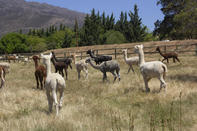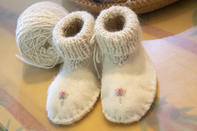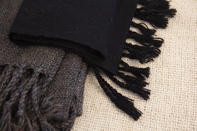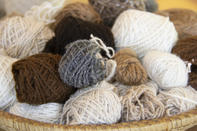Alpaca fleece has been used for millennia for their durable soft and insulating fibre.

As they are semi-domesticated members of the South American camelids, they are shorn once a year in springtime. Alpaca farming in South Africa is thus a viable industry as the animal can efficiently convert food to wool - alpacas are considered the most efficient fibre-producing animal.
Properties of Alpaca Fibres

Alpaca fibre is very fine and therefore downy, almost silky, to the touch. It is said to be five times stronger and finer than wool and also longer than most other natural fibres. Various factors determine the softness of alpaca fibre. Individual alpaca fibres consist of outer ‘scales’ lying against the shaft of the fibre.
The scale height of alpaca fibre is about 0.04 microns compared to 0.08 microns for wool. This, in practice, means alpaca fibre feels softer than wool. The scales are longer than both wool and mohair, again enhancing the smoothness of alpaca fibre over the other two types of fibre.
Alpaca fibre is water-resistant, resist solar radiation and contains microscopic air pockets giving it insulation properties.
It does not contain lanolin, an oily substance secreted by wool-producing animals. The residue from the chemicals required to eliminate lanolin from sheep's wool often causes itchiness as a symptom of an allergic reaction. However, alpaca fibre does not cause this irritation and is suitable for use in baby garments and for people with sensitive skin.
Alpaca fleece comes in 22 different colour and shade classifications and several classifications of fineness ranging between about 16 and 30 microns. The lower the micron the finer and softer it is. Colours range from white, shades of brown, and grey to black with white being the predominant colour.
Types of Alpaca Fleece

There are two phenotypes of alpacas, the Huacaya with its more sheep-like spongy fibre and the Suri alpaca with its longer, smoother fibre. Huacaya fibre has a wavy fibre that retains its shape over time and is more suitable for knitted products. Suri fibre has a certain silk-like lustre and is preferred for high-end products such as alpaca suits.
Alpaca fleece needs to be graded well to reduce the occurrence of coarse fibre, called guard hair. Factors such as poor genetics, high protein content in alpaca feed, and the animal’s age can cause coarsening of the fibre.
Processing Alpaca Fleece

There are various facets involved in the production of alpaca fibre products. The process starts with fleece harvesting. Alpaca fleece (or fibre) is harvested once a year in September or October, depending on the severity of South African’s winter.
All adults and crias (baby alpacas) as young as six months are shorn by a specially trained alpaca shearer using equipment that is similar to the ones used for sheep. A cria produces about 1 kg of fibre while an adult alpaca can produce about 2.5 kg or sometimes more.
The fibre is then hand-picked clean to remove vegetative matter such as thorns and grass. Then the alpaca fibre of similar colours is combined. Some alpaca fleece producers may collect bits of similar-coloured fibre in a ‘spots’ lot. For example, brown fibre from a white animal with a small patch of brown.
Skirting is the process during shearing (or afterwards) when the visible coarse ‘guard hair’ - which may measure over 30 microns is removed from the fine part of the fleece. The actual de-hairing process at the mill removes the rest of the thicker straight hairs.
Fibre is then sent for processing at a special mill in Butterworth in the Eastern Cape. Calibration of machinery used for mohair processing is not able to process alpaca fibre. Fibre is first washed while keeping colours separate, air-dried and then carded. Carding aligns the alpaca fibres in parallel. After carding the fibres are ready for spinning into knitting or weaving yarns.
Genetics and Alpaca Fleece
Breeding for a specific colour fleece is a complicated affair in alpaca farming, especially the colour grey. Much research is being done on breeding for this colour, says Alison Notley, president of the South African Alpaca Breeders Society and owner of Helderstroom Alpacas.
Australia is doing much to improve the genetic quality of alpaca fleece especially in terms of variation in fibre thickness, reducing inferior fleece portions and reducing the ratio of primary to secondary fibres (coarse guard hair).
By Marinda Louw